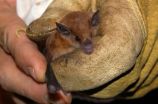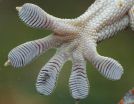(Press-News.org) For decades, scientists have used techniques like X-ray crystallography and nuclear magnetic resonance imaging (NMR) to gain invaluable insight into the atomic structure of molecules, but such efforts have long been hampered by the fact that they demand large quantities of a specific molecule and often in ordered and crystalized form to be effective – making it all but impossible to peer into the structure of most molecules.
Harvard researchers, however, say those problems may soon be a thing of the past.
A team of scientists, led by Professor of Physics and of Applied Physics Amir Yacoby, have developed a magnetic resonance imaging (MRI) system that can produce nano-scale images, and may one day allow researchers to peer into the atomic structure of individual molecules. Their work is described in a March 23 paper in Nature Nanotechnology.
"What we've demonstrated in this new paper is the ability to get very high spatial resolution, and a fully operational MRI technology," Yacoby said. "This work is directed towards obtaining detailed information on molecular structure. If we can image a single molecule and identify that there is a hydrogen atom here and a carbon there…we can obtain information about the structure of many molecules that cannot be imaged by any other technique today."
Though not yet precise enough to capture atomic-scale images of a single molecule, the system has already been used to capture images of single electron-spins. As the system is refined, Yacoby said he expects the system will eventually be precise enough to peer into the structure of molecules.
While the system designed by Yacoby and colleagues operates in much the same way as conventional MRIs do, the similarities end there.
"What we've done, essentially, is to take a conventional MRI and miniaturize it," Yacoby said. "Functionally, it operates in the same way, but in doing that, we've had to change some of the components, and that has enabled us to achieve far greater resolution than conventional systems."
While conventional systems, Yacoby said, can achieve resolutions of less than a millimeter, they are effectively limited by the magnetic field gradient they can produce. Since those gradients fade dramatically within just feet, conventional systems built around massive magnets designed to create a field large enough to image an object – like a human – that may be a meter or more in length.
The nano-scale system devised by Yacoby and colleagues, by comparison, uses a magnet that's just 20 nanometers in diameter – about 300 times smaller than a red blood cell – but is able to generate a magnetic field gradient 100,000 times larger than even the most powerful conventional systems.
The difference, Yacoby explained, is that the nano-scale magnet can be brought incredibly close – to within a few billionths of a meter – to the object being imaged.
"By doing that, we can achieve spatial resolution that's far better than one nanometer," Yacoby said.
Their departures from conventional MRI systems, however, didn't end there.
To construct a sensor that could read how molecules react to that magnetic field gradient, Yacoby and colleagues turned to a field that would appear to be unconnected to imaging – quantum computing.
Using ultra-pure, lab-grown diamonds, the team milled tiny devices, each of which ended in a super-fine tip, and embedded an atomic-scale impurity, called a nitrogen-vacancy (NV) center in each tip, creating a single quantum bit, or qubit – the essential building block of all quantum computers.
In experiments published last year, Yacoby and his collaborators showed that, as the tip was scanned across the surface of a diamond crystal, the quantum bit interacts with electron spins near the crystal's surface. Those interactions could then be used to create an image of individual electron spins. However, while the sensitivity of the quantum bit sensor is sufficient to detect individual electron spins and represented a quantum leap forward from earlier efforts its spatial resolution is limited by its distance to the object that is being imaged.
To create truly three-dimensional images, Yacoby and colleagues combined the quantum bit sensing approach with the large field gradient by bringing the nano-magnet in close proximity to both the sample of interest and the qubit sensor. By scanning the magnet in 3 dimensions but very close to the sample, they were able to detect individual electron spins as they reacted to the magnetic field.
"This is really a game of bringing both the magnet very close to generate large gradients, and bringing the detector very close to get larger signals," Yacoby said. "It's that combination that gives us both the spatial resolution and the detectability.
"Our current system is already capable of imaging individual electron spins with sub nm resolution," Yacoby said. "The goal, eventually, is to put a molecule in proximity to our NV center to try to see the components within that molecule, namely the nuclear spins of the individual atoms composing it. This is by no means an easy task since the nuclear spin generates a signal that is a thousand times smaller than that of the electron spin… but that's where we're headed."
INFORMATION:
MRI, on a molecular scale
Researchers develop system that could one day peer into the atomic structure of individual molecules
2014-04-18
ELSE PRESS RELEASES FROM THIS DATE:
Stanford researchers rethink 'natural' habitat for wildlife
2014-04-18
Protecting wildlife while feeding a world population predicted to reach 9 billion by 2050 will require a holistic approach to conservation that considers human-altered landscapes such as farmland, according to Stanford researchers.
Wildlife and the natural habitat that supports it might be an increasingly scarce commodity in a world where at least three-quarters of the land surface is directly affected by humans and the rest is vulnerable to human-caused impacts such as climate change. But what if altered agricultural landscapes could play vital roles in nurturing wildlife ...
Finding turns neuroanatomy on its head
2014-04-18
Harvard neuroscientists have made a discovery that turns 160 years of neuroanatomy on its head.
Myelin, the electrical insulating material long known to be essential for the fast transmission of impulses along the axons of nerve cells, is not as ubiquitous as thought, according to a new work lead by Professor Paola Arlotta of the Harvard Stem Cell Institute (HSCI) and the University's Department of Stem Cell and Regenerative Biology, in collaboration with Professor Jeff Lichtman, of Harvard's Department of Molecular and Cellular Biology.
"Myelin is a relatively recent ...
Researchers question published no-till soil organic carbon sequestration rates
2014-04-18
URBANA, Ill. For the past 20 years, researchers have published soil organic carbon sequestration rates. Many of the research findings have suggested that soil organic carbon can be sequestered by simply switching from moldboard or conventional tillage systems to no-till systems. However, there is a growing body of research with evidence that no-till systems in corn and soybean rotations without cover crops, small grains, and forages may not be increasing soil organic carbon stocks at the published rates.
"Some studies have shown that both moldboard and no-till systems ...
Sun emits a mid-level solar flare
2014-04-18
The sun emitted a mid-level solar flare, peaking at 9:03 a.m. EDT on April 18, 2014, and NASA's Solar Dynamics Observatory captured images of the event. Solar flares are powerful bursts of radiation. Harmful radiation from a flare cannot pass through Earth's atmosphere to physically affect humans on the ground, however -- when intense enough -- they can disturb the atmosphere in the layer where GPS and communications signals travel.
To see how this event may impact Earth, please visit NOAA's Space Weather Prediction Center at http://spaceweather.gov, the U.S. government's ...
Researchers find 3-million-year-old landscape beneath Greenland ice sheet
2014-04-18
Glaciers and ice sheets are commonly thought to work like a belt sander. As they move over the land they scrape off everything — vegetation, soil and even the top layer of bedrock. So a team of university scientists and a NASA colleague were greatly surprised to discover an ancient tundra landscape preserved under the Greenland Ice Sheet, below two miles of ice.
"We found organic soil that has been frozen to the bottom of the ice sheet for 2.7 million years," said University of Vermont geologist and lead author Paul Bierman. The finding provides strong evidence that the ...
Religious music brings benefit to seniors' mental health
2014-04-18
A new article published online in The Gerontologist reports that among older Christians, listening to religious music is associated with a decrease in anxiety about death and increases in life satisfaction, self-esteem, and sense of control over their lives. In particular, listening to gospel music is associated with a decrease in anxiety about death and an increase in sense of control.
These associations are similar for blacks and whites, women and men, and individuals of both low- and high-socioeconomic status.
The article, titled "Listening to Religious Music and ...
Ancient DNA offers clues to how barnyard chickens came to be
2014-04-18
Durham, NC — Ancient DNA adds a twist to the story of how barnyard chickens came to be, finds a study to be published April 21 in the journal Proceedings of the National Academy of Sciences.
Analyzing DNA from the bones of chickens that lived 200-2300 years ago in Europe, researchers report that just a few hundred years ago domestic chickens may have looked far different from the chickens we know today.
The results suggest that some of the traits we associate with modern domestic chickens -- such as their yellowish skin -- only became widespread in the last 500 years, ...
Plants with dormant seeds give rise to more species
2014-04-18
Durham, NC — Seeds that sprout as soon as they're planted may be good news for a garden. But wild plants need to be more careful. In the wild, a plant whose seeds sprouted at the first
warm spell or rainy day would risk disaster. More than just an insurance policy against late frosts or unexpected dry spells, it turns out that seed dormancy has long-term advantages too: Plants whose seeds put off sprouting until conditions are more certain give rise to more species, finds in a team of researchers working at the National Evolutionary Synthesis Center in North Carolina.
When ...
Gecko-like adhesives now useful for real world surfaces
2014-04-18
AMHERST, Mass. – The ability to stick objects to a wide range of surfaces such as drywall, wood, metal and glass with a single adhesive has been the elusive goal of many research teams across the world, but now a team of University of Massachusetts Amherst inventors describe a new, more versatile version of their invention, Geckskin, that can adhere strongly to a wider range of surfaces, yet releases easily, like a gecko's feet.
"Imagine sticking your tablet on a wall to watch your favorite movie and then moving it to a new location when you want, without the need for ...
'Exotic' material is like a switch when super thin
2014-04-18
ITHACA, N.Y. – Researchers from Cornell University and Brookhaven National Laboratory have shown how to switch a particular transition metal oxide, a lanthanum nickelate (LaNiO3), from a metal to an insulator by making the material less than a nanometer thick.
Ever-shrinking electronic devices could get down to atomic dimensions with the help of transition metal oxides, a class of materials that seems to have it all: superconductivity, magnetoresistance and other exotic properties. These possibilities have scientists excited to understand everything about these materials, ...
LAST 30 PRESS RELEASES:
Heart-brain connection: international study reveals the role of the vagus nerve in keeping the heart young
Researchers identify Rb1 as a predictive biomarker for a new therapeutic strategy in some breast cancers
Survey reveals ethical gaps slowing AI adoption in pediatric surgery
Stimulant ADHD medications work differently than thought
AI overestimates how smart people are, according to HSE economists
HSE researchers create genome-wide map of quadruplexes
Scientists boost cell "powerhouses" to burn more calories
Automatic label checking: The missing step in making reliable medical AI
Low daily alcohol intake linked to 50% heightened mouth cancer risk in India
American Meteorological Society announces Rick Spinrad as 2026 President-Elect
Biomass-based carbon capture spotlighted in newly released global climate webinar recording
Illuminating invisible nano pollutants: advanced bioimaging tracks the full journey of emerging nanoscale contaminants in living systems
How does age affect recovery from spinal cord injury?
Novel AI tool offers prognosis for patients with head and neck cancer
Fathers’ microplastic exposure tied to their children’s metabolic problems
Research validates laboratory model for studying high-grade serous ovarian cancer
SIR 2026 delivers transformative breakthroughs in minimally invasive medicine to improve patient care
Stem Cell Reports most downloaded papers of 2025 highlight the breadth and impact of stem cell research
Oxford-led study estimates NHS spends around 3% of its primary and secondary care budget on the health impacts of heat and cold in England
A researcher’s long quest leads to a smart composite breakthrough
Urban wild bees act as “microbial sensors” of city health.
New study finds where you live affects recovery after a hip fracture
Forecasting the impact of fully automated vehicle adoption on US road traffic injuries
Alcohol-related hospitalizations from 2016 to 2022
Semaglutide and hospitalizations in patients with obesity and established cardiovascular disease
Researchers ‘listen in’ to embryo-mother interactions during implantation using a culture system replicating the womb lining
How changing your diet could help save the world
How to make AI truly scalable and reliable for real-time traffic assignment?
Beyond fragmented markets: A new framework for efficient and stable ride-pooling
Can shape priors make road perception more reliable for autonomous driving?
[Press-News.org] MRI, on a molecular scaleResearchers develop system that could one day peer into the atomic structure of individual molecules





